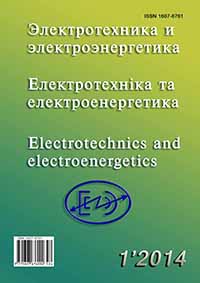FEATURES OF THE OF THERMAL EFFECT IMPACT ON THE ASYNCHRONOUS MOTOR WITH THE MODIFIED PULSE CONTROL SYSTEM IN CONDITIONS OF FREQUENT STARTS
DOI:
https://doi.org/10.15588/1607-6761-2014-1-5Keywords:
regulation, asynchronous motor, temperature, start-up, pulseAbstract
Currently there is no information about the optimal value of the rate of change pulse duty factor coefficient in speedingup modes of asynchronous motor (AM) with the modified pulse control system, where the impact components of the thermal effect intensity is the lowest one.The aim is to estimate the derivation of the stator temperature, the temperature of AM with the modified system in conditions of frequent starts, depending on the intensity of its speed up.
To estimate the derivation of the stator temperature, the temperature of AM with the modified system, depending intensity of its speed up the complex simulation model of electromagnetic and thermal process are designed. This model describes the thermal transient process in structural elements of AM and allows considering peculiarities of electromagnetic energy transformation in thermal energy, heat transferring and heat interchanging processes. The use of AM with the modified system pulse control will reduce the derivation of the stator temperature, the temperature of AM up to 12 times compared to derivation of the stator temperature, the temperature of AM at direct start. The optimal thermal conditions of AM at rate of change pulse duty factor coefficient equal to 0,16 pu/s is provided.
The results of research can be used to optimize the design of pulse control systems, thermal protection of AM with the modified system for heavy-duty, where the frequency of starts reaches 3000 cycles per hour
References
Краново-металлургические электродвигатели [Текст] / [Н. М. Баталов, В. А. Белый, А. Б. Иоффе и др.]. – М. : Энергии, 1967. – 238 с.
Сипайлов Г. А. Тепловые гидравлические и аэродинамические расчеты в электрических машинах [Текст] / Г. А. Сипайлов, Д. И. Санников, В.А. Жадан. – М. : Высш. Шк., 1989. – 240 c.
Коцур М. И. Особенности режимов работы модифицированной системы импульсного регулирования асинхронного двигателя с фазным ротором [Текст] / М. И. Коцур, П. Д. Андриенко, И. М. Коцур // Електромеханічні і енергозберігаючі системи. – Кременчук : КрНУ, 2012. – №3(19). – С. 163–165.
Копылов И. П. Математическое моделирование электрических машин [Текст]/ И. П. Копылов. – М. : Высшая школа, 2001. – 327 с.
Bonnett Austin H. Operating temperature considerations and performance characteristics for IEEE 841 motors [Text] / Bonnett Austin H // IEEE Trans. Ind. Appl. – 2011. – 37, No. 4. – P. 1120–1131.
Коцур М. И. Оценка ресурса системы изоляции управляемого асинхронного двигателя с фазным ротором в подсинхронном диапазоне частоты вращения ротора [Текст] / М. И. Коцур, П. Д. Андриенко, И. М. Коцур // Восточно-европейский журнал передовых технологий. – 2011. – №5/8(53). – С. 41–45.
Коцур М. И. Оценка теплового состояния изоляции асинхронного двигателя с фазным ротором с модифицированной системой импульсного регулирования [Текст] / М. И. Коцур, // Електротехніка та електроенергетика. – 2013. – №1. – С. 31–36.
Abreu J. P. Induction motor thermal aging caused by voltage distortion and im-balance: loss of useful life and its estimated cost [Text] / J. P. Abreu, A. E. Emanuel // IEEE Transactions on Industry Applications. – 2008. – No. 1. – P. 12–20.
Hameyer K. Thermal computation of electrical machines [Text]/ K. Hameyer, U. Pahner, R. Belmans, H. Hedia// 3rd international workshop on electric & Magnetic fields, Liиge, Belgium, May 6–9, 2009, P. 61–66.
Downloads
How to Cite
Issue
Section
License
Copyright (c) 2017 M. I. Kotsur

This work is licensed under a Creative Commons Attribution 4.0 International License.
Creative Commons Licensing Notifications in the Copyright Notices
Authors who publish with this journal agree to the following terms:
Authors retain copyright and grant the journal right of first publication with the work simultaneously licensed under aCreative Commons Attribution License that allows others to share the work with an acknowledgement of the work's authorship and initial publication in this journal.
Authors are able to enter into separate, additional contractual arrangements for the non-exclusive distribution of the journal's published version of the work (e.g., post it to an institutional repository or publish it in a book), with an acknowledgement of its initial publication in this journal.
Authors are permitted and encouraged to post their work online (e.g., in institutional repositories or on their website) prior to and during the submission process, as it can lead to productive exchanges, as well as earlier and greater citation of published work.

